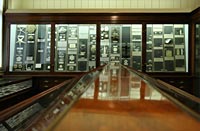
Walter Percy Sladen- marine biologist
Return to Exeter People Menu
To have a gallery named after you in the Royal Albert Memorial Museum would indicate a life of some repute, and yet, how many in Exeter know anything of the man whose name is given to the Sladen Gallery, a gallery of dried starfish and other small sea creatures.
Born in Halifax, on the 30th June 1849 to a prosperous leather merchant, Percy Sladen's mother died when he was ten. His father remarried and his stepmother had eight children of her own. Percy was sent at the age of 11 to Hipperholme Grammar School and then on to Marlborough College where he became a classical linguist. He formed a scientific society while at school, and on his return to Halifax, he continued his hobby of natural history, at a time when the discoveries of Charles Darwin were dominating scientific thought. Sladen co-founded the Halifax Philosophical and Literary Society, and with like minded friends, started collecting specimens from around the coast of Britain.
Gradually, Sladen became interested in the study of echinoderms, or starfish and sea urchins. Knowledge of his expertise spread, and a strange specimen of a echinoderm that was a cross between a start fish and brittle star was sent to him by Anton Dohrn, of the Stazione Zoologica di Napoli to study. The specimen was of interest as it was seen as an intermediate form between two species, as suggested by Darwin in Origin of the Species. Between December 1878 and February 1879, Sladen worked at the British Association for the Advancement of Science at Naples.
After the HMS Challenger expedition of 1872 to 1876, the organisers of the voyage, Sir Charles Wyville Thomson and professor William Carpenter approached Sladen in 1881 to study and prepare the many specimens of starfish that had been dredged up. Over the next ten years, Sladen produced 1,000 pages of text and 118 illustrations, along with thousands of prepared specimens. His work describing 34 new genera and 184 new species from the Challenger, led him to studying specimens from HMS Albatross and other expeditions. To facilitate his studies, he moved to Surrey in 1883, to be closer to the learned institutions in London. In 1890, he married Constance Anderson, who was herself, an expert on the archaeology of Yorkshire.
His uncle John Dawson owned the 31 acre estate of Northbrook Park at Countess Wear. In 1894, Percy Sladen became more involved in family affairs, and in the management of his uncles estate. He inherited the estate at his uncles death in 1898 and moved into Northbrook Lodge, the main house. Percy Sladen was also a generous philanthropist, paying £2,000 to insure the lives of the men of the Devonshire Yeomanry and Volunteers who fought in the Boer War.
In 1899, he purchased the Countess Wear paper mill, which had been disused since 1885, the leat of which bounded the southern edge of Northbrook Park. He converted the mill to generate electricity for his estate, which it did so, until the 1940s when the house was in use after the May 1942 blitz as a civil defence headquarters. In 1946 the house was compulsorily purchased from Mrs Kerr, a distant cousin of Constance and converted into flats. In 1954 it was demolished and the estate became the site of the Devon and Exeter Crematorium; the fountain in the memorial park was right in front of Northbrook Lodge.
Sladen had experienced continuous ill health from at least 1890, and had several debilitating bouts of flu. On a visit to Florence, he collapsed and died on 11th June 1900. His body was returned to England to be buried in St Luke's Church, Countess Wear. Constance, his widow promoted her husbands life work and in 1903 Mrs Sladen gifted the Percy Sladen collection to the Royal Albert Memorial Museum, and also paid £500 for the special, walk in exhibition gallery to house the collection and £1,000 towards the salary of the Curator in charge of the collection. In 1904, Mrs Slade endowed £20,000 in the Percy Sladen Trust for scientific research, a trust which went on to finance several more expeditions of scientific study. Mrs Sladen died in 1906 and was buried next to her husband at St Luke's.
Based on a Biography of Percy Sladen by David Nichols and published by the Linnean Society.
 The Sladen Gallery
The Sladen Gallery
│ Top of Page │